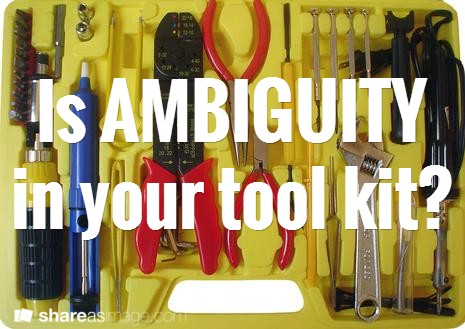
Every now and then I get asked what I think are the most important skills or behaviors for people to have in their professional kit bag today. These have evolved in my view over the years, and certainly when I was starting out about 25 years ago, the skills that were essential then are different to today.
The notions of hierarchy, role clarity and speed of change are vastly different. As the work we are doing increasingly moves online, to larger and more fragmented audiences the need for people to be able to work collaboratively together to achieve outcomes and overcome issues is paramount, as is the topic of today’s blog – the ability to work with ambiguity.
But what does that mean?
Simply put, it means being able to be effective when there are no rules. When there is no playbook of what to do and when. Where there is doubtfulness or unertainanty in the tasks we perform. In short you need to figure out what to do when nobody is watching. And be prepared to accept responsibility for it.
It’s important to understand if you are a person who can cope with ambiguity before searching for, or finding yourself in a role where this is required. Are you comfortable with change? Are you happy to make decisions without all the data? Can you cope with uncertainty and risk? Really?
Certainly the lessons of working with ambiguity are fresh in my current role – starting up Pandora Internet Radio in Australia and New Zealand. Having been successful in securing the role, I headed over to the US for induction/whirlwind introductions and headed straight back to launch the product with our founder for a couple of weeks – it was nonstop. Then he got on a plane and went back, and I literally thought, as I sat in my office for one (the spare bedroom of our house)…..what next? As the first subsidiary outside of the US (where we have over 200 million registered users) there was no blueprint.
And so you figure it out. A key fall back from me is always the good old gap analysis – where am I now/where do I need to be/what is the gap/actions to close the gap (I’ve always been fond of a four point plan). It helps enormously to be clear about the problem you are trying to solve and this type of analysis is helpful – as are the techniques of “chunking up and chunking down” – understanding both the big picture as well as an appropriate level of detail.
When working with ambiguity you need to give up on the ideas of perfection and completion. I always had a saying with my team in working in internet business – “get to eighty and go”. Get to about 80% of the answer, or as much as you can and then go live. The nice thing about the immediacy of the feedback from audiences online is that you can watch and tweak, realign the course. You don’t need to get it 100% right up front, and if you wait for that, it will be too late.
I could go on, but I won’t. One of these days I’d like to write a blog about another essential skill, but one I am yet to master – that of “managing up”. Maybe another day….